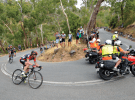It’s funny how life tends to throw obstacles in the way whenever you set out to undertake a dedicated training program. Those who spend time in paid employment, working and/or running a household, caring for children, and managing commitments to elderly parents can find it difficult to make the time to dedicate time to themselves. It’s a challenge that you can overcome with planning and persistence.
Women have their own unique health issues like menstrual cycles and even pregnancy and childbirth, and once they get past that, there’s menopause to deal with. All of these factors have to be considered when embarking on a training program.
When it comes to partners, it’s important to gain their support for your training goals so make sure you discuss what you’re planning with them. You may also have to call on extended family and friends to help out in order for you to spend enough time on your bike to reach your goals.
Set a goal
Speaking of which, you need to set yourself a goal before you can begin working towards it. Without a specific goal, you might as well just continue to be a keen recreational cyclist. There is of course nothing wrong with that, but if you’re serious about training you need to know where you are heading.
You should ride regularly and make cycling your main form of exercise (at least three quarters of your time). That doesn’t mean you should give up your regular gym sessions but if you’re really serious about riding, then you should tailor your sessions to complement your cycling goals.
Don’t make it so easy that you’ll achieve it in the first month; make it a challenge. And make sure it’s specific, like ‘I’m going to research all the cycling clubs in my area, join up and try my first race by the middle of this year’. Or ‘I’m going to participate in a timed ride like the Amy Gillett Gran Fondo in September 2014’.
Your goal may be club racing but there are also rides like the Blayney to Bathurst Sportif held in April each year. Sportifs are timed rides which you can enter as a team or individually. There are winners in each age category and team prizes too, so it gives you something to aim for, and you can return year after year to see how your time improves. Of course, large charity rides like Sydney’s annual Gong ride or Melbourne’s Around the Bay also offer you a challenge but they are not timed rides and they tend to attract riders of all levels, whereas the Sportifs are designed with more serious cyclists in mind.
It is also important to remember that you need to build a solid base or foundation to your fitness and ability. This takes years but you can achieve quite a lot in a matter of months. Anna Meares took many years to reach her true potential and that’s both a physical conditioning/maturity thing as well as the mental maturity for race tactics.
Research
Be an information gatherer. Some men tend to leap enthusiastically into new pursuits whereas women may employ a more cautious approach, taking time and researching the subject thoroughly before diving in, but these days that doesn’t involve heading to the library.
There are plenty of resources. Ask others, particularly other women who you can see are doing well in your chosen pursuit. Do they have a coach or do they go it alone? Would they recommend their own approach? What’s their story?
There are also plenty of good books and online resources you can access as well. I particularly like Gale Bernhardt’s Bicycling for Women because it’s written specifically for female cyclists but there are lots of books about developing your own training program.
Measuring and recording
You can measure and record your progress in a number of ways. Firstly, you need a good bicycle computer like a Garmin or Magellan device that is specifically designed for cycling. It needs to record important parameters like distance, speed, time, average speed, cadence, heart rate and power output.
Most people who become serious about training will buy a power meter. You can read more about power meters in a series of articles by James McArdle from the March/April 2013 and May/June 2013 issues of Bicycling Australia. In James’ Masterclass he explains that power is measured in Watts and that most power meters use strain gauges to measure torque applied either to the bottom bracket, pedal, rear hub or cranks. Strain gauges measure the pressure applied by the force of the body. There is a also a number of power meters in the Test Lab section of the last issue of Bicyling Australia March/April 2014.
However if you don’t have a power meter you can use other measurements like your own perceived rate of exertion or heart rate. Either way you need to measure your rides so you can see if you are improving. It will also help you identify weaknesses like hill climbing.
The role of intervals
Interval training is characterised by low and high intensity workout periods, inter-dispersed with rest periods. The main aim is to improve speed and cardiovascular fitness. Women and men will benefit equally from interval training. According to a study published in The Journal of Physiology, three sessions of sprint interval training are as effective as five sessions of longer endurance exercise which is great news for time-poor women.
Michael Hanslip has written several Masterclass articles on the use of intervals in training programs including in the March April issue of Bicycling Australia and this one too, so consult those for a longer explanation of the important role of intervals and how you can incorporate them into your program.
A couple of important rules include: the effort needs to be even throughout the interval period, the effort needs to be even from one interval to the next, the on and off period are equally important, you get out what you put in and the mental part of a interval training is critical.
Hiring a coach
While you can set your goal, undertake your research and write your own program, there is no substitute for hiring an experienced coach who can work with you to develop a tailored program. Having someone monitor your progress and encourage you to keep going is also very motivating.
Sydney-based cycling coach Donna Meehan says that coaching is a very personal bond between athlete and coach, and it’s a two way street. The more information and feedback you give to your coach, the more accurate and succinct the training will be for you.
“In general, women are very focused once they make the decision to train for a specific event. I think this is because they have made the commitment to take time away from other factors of their life such as children and their social life. They sometimes find it hard to juggle everything, but once they have set their goals not much stops them,” says Donna.
Donna says that when she develops a program it is tailored to the person rather than being gender specific.
“When writing programs they are designed for that person’s specific goals for the season, taking into account their base fitness and factors like max HR and threshold power output, so the basics are the same. Where they do differ is in the length of women’s races that are often shorter distances and less days, so I need to take this into account when writing a program. The quality and intensity is set specifically for each athlete.
“So I find that if I get a woman to focus more on developing muscular endurance, power and anaerobic endurance quality, over just basic time on the bike, they are usually more successful in their races. Females also have less muscle mass then males (approx 30% less) and need to spend time developing and maintaining upper body strength in their arms and core,” she added.
Donna does however stress that while you need to stick to a program you need to have fun as well, so don’t forget to factor in some social rides and of course, the all important café visits.
Many coaches work remotely with their clients but if you are new to hiring a coach I think it is better to find someone who you can actually meet face-to-face and ride with, so you can develop a good bond and trust in their program.
Developing your skills
Any rider, male or female, looking to improve should be willing to admit that they don’t possess great bike riding skills and seek out ways to rectify their problem areas.
“I sometimes have to do more work with women on skills because they may start off less skilful than their male counterparts, mainly through lack of experience but in general they are very keen to learn and will always ask questions about technique. This makes them very quick learners and improvement in skills usually comes very quickly,” says coach Donna Meehan.
There are workshops run by various organisations that can help develop general bike skills as well as specific racing skills. St Kilda Cycling Club in Melbourne runs a program called Latte Laps for new riders to learn about crit racing and a program for new female members to learn bike skills, and there are similar programs run by other clubs and cycling bodies.
It’s important to never stop learning. You (and your coach) should look for gaps in your ability and find ways to enhance those. It could be through a skills program, specific coaching, reading a book or doing a program.
Nicola writes a cycling blog called Women Who Cycle (http://womenwhocycle.com) and works in the cycling industry in Sydney.

